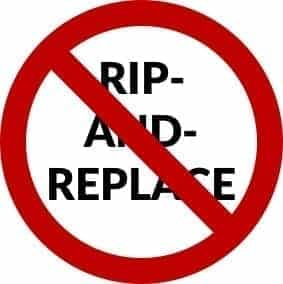Here’s a nightmare scenario for too many CIOs and CTOs who have lived through it before: You’re adopting a cornerstone technology or software tool, but adopting it demands rip-and-replace of existing architectures and software. No wonder they’re a little leery of making the move…or if they do, they feel absolutely compelled to junk legacy systems and rebuild from scratch.
In the case of workflow automation adoption, though, bringing on a new WFA platform for your enterprise shouldn’t mean you have to jettison legacy systems. There’s a place for those established and still-viable systems, as Wolfram Jost, CTO of German platform provider Software AG, pointed out in a 2017 interview:
“Certainly, digitalization and, say, the Internet of Things demand new digital business processes, but to throw out, to ‘rip and replace,’ the software solutions developed over decades would be throwing out the baby with the bathwater to an absurd degree.
“It is estimated that 350 billion lines of COBOL code are in operation globally, processing up to 30 billion transactions representing one trillion dollars of business daily. Looking just at the United States, 95 percent of ATM transactions, 80 percent of point-of-sale transactions and over 90 percent of vacation bookings use COBOL. The average American probably interacts with the language more than 10 times a day.”
Nearly every large enterprise has legacy technology on board that still serves an essential role. But those CIOs and CTOs we mentioned are also being pressured to evolve quickly yet cost-effectively. They need to introduce more efficient platforms to build agility and cut expenses, but can’t afford to trash old-line systems.
Integration, but hold the migraines

These legacy systems are so embedded within the enterprise infrastructure that replacing them isn’t just an IT problem, but a headache for the entire organization. Business processes and profitability may be seriously disrupted.
It’s often not financially feasible to make the move anyway. Compliance demands or business models may change, but there’s rarely a good enough reason to make a wholesale revamp that impacts the whole operation and drags down the bottom line.
So to improve operational agility, responsiveness, and efficiency, technology leads at these companies need to find software solutions that deliver seamless integration with legacy platforms. Plus, an ideal WFA solution should also play very politely with other third-party software applications the enterprise may rely upon.
The need for an easy-to-adopt, flexible and scalable workflow automation platform that fits this bill is why enterprises have tended to embrace SaaS-based solutions capable of integrating handily with in-place platforms. How should this play out in practice?
Uniting the enterprise, one workflow at a time
Let’s imagine you’ve adopted a WFA platform that promises this kind of integration, and it’s got to work with an ERP system that’s already implemented:
- When a form that’s been built within the WFA system, such as a customer order form, is routed through an automated order intake workflow, data from the form is also sent into the ERP via a connector.
- The ERP generates an order, and kicks off a fulfillment workflow in the WFA platform, again via connector.
- A fulfillment specialist receives a notification that an order is being processed.
- Meanwhile, the WFA platform centrally stores all forms and associated documents, so the receivables or customer service teams can access them via the ERP.
Manual entry is eliminated, which speeds up fulfillment. Every leg of the process is automated, uniting disparate systems and d-bases into a far more integrated and efficient whole.

Other benefits? Now, the everyday efficiencies and process improvements involved in adopting a SaaS workflow automation platform are being actualized. Better still, your enterprise has moved the needle on digital transformation in a big way, while dodging the pains and costs that would have accompanied a rip-and-replace scenario.
That’s a win-win outcome for everyone involved – CFO, CIO and employees alike.


